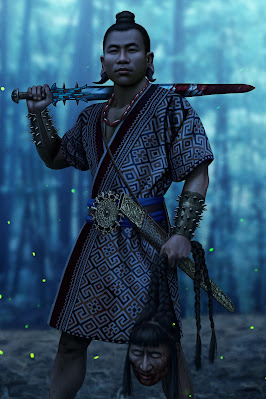Kingdom of Dian Brave: 滇国勇士

A Dian head hunting warrior of what is today's Yunnan Province. He carries an elaborate bronze fitted scabbard and wears a silk armor bearing distinctive steppe designs from Central Asia (likely Saka or Yuezhi.) It is possible that the Dian people had spoken a language belonging to the Tibeto-Burman family. His bracers and ear horn ornaments are inspired by the Naga people who lived in modern Northeast India. Dian left behind a rich bronze material culture which depicted scenes of battle, ritual, parade, hunting, etc. Dian art often depicts scenes of headhunting and severed heads of their long-haired enemies, and their most depicted animal is the ox.

Dian "滇," was a kingdom that once thrived in Yunnan. According to Sima Qian's Records of the Grand Historian; the kingdom was founded by General Zhuang Qiao of the Kingdom Chu. Recent archaeology- however deputes this original claim, as there seemed to be no Chu artifacts reflecting its customs unearthed from the region at this time.

If anything the culture of the region exhibited much of the traits of the indigenous people with evidence of exchange with proto- Burmese- and Tibetan people. Their Kings however did sought after prized treasures from China. The inscription on the Dian King's tombs bore seal script on a gold imperial seal of investiture given by the Han Emperor. As the Dian did not have their own writing and thus kept their own records, there's very little we know of the ancient kingdom.

Music: Followers of the Flame
Bronze sword handle: Dian culture, 2- 1st century BC. The end of the handle is pyramidal, the handle decorated with pins, while the elaborate guard is indented so as to socket chips of precious gems.
Apart from the sources, archaeologists have identified a distinctive Bronze Age material culture around the lakes of Yunnan that corresponds with the kingdom of Dian. The art of the Dian was highly figurative and naturalistic, in contrast with the more stylised and abstract art of the early dynasties of China. Their bronzes show scenes of battle, ritual, parade, hunting, etc. Dian art often depicts scenes of headhunting and severed heads of their long-haired enemies, and their most depicted animal is the ox.
From Dian bronzes we can also tell they wore heavy lamellar armours, with arm guards, neck guards, helmets and greaves. Dian belt buckle depicting heavily armored warriors with dagger axes escorting prized water buffalos. Water buffalos are heavily depicted in Dian artifacts and seemed to hold great cultural significance for the Dian. Most Dian are farmers or semi- migratory water buffalo herders. The heavy armor of the Dian warriors bears somewhat of a resemblance to the famed Dendra panoply of ancient Mycene. Interestingly, traditions of similarly heavily armored warriors convergently emerged again in Yunnan and was used by the Miao people.


ANNEXATION BY THE HAN DYNASTY
The kingdom of Dian was eventually annexed by the Han dynasty under the aggressive leadership of Emperor Wu. Emperor Wu of Han was an aggressive statesman, and was not only known to have destroyed the Xiongnu (Hunnic) threat in the empire's northern but also sent out multiple expeditions to subdue the kingdoms to his south, they would expand as far as modern Vietnam in the east and in the west- Wu took over the kingdom of Dian and established several commanderies.
Music: Sea of Clouds


Thank you to my Patrons who has contributed $10 and above: You made this happen!
➢ ☯ Muramasa
➢ ☯ MK Celahir
➢ ☯ Kevin
➢ ☯ Vincent Ho (FerrumFlos1st)
➢ ☯ BurenErdene Altankhuyag
➢ ☯ Stephen D Rynerson
➢ ☯ Michael Lam
➢ ☯ Peter Hellman
➢ ☯ SunB

Bronze Sword with Snake-shaped Handle; Gold Sheath Ornaments. Western Han Dynasty. Unearthed from Shizhaishan, Jinning County.






















Comments
It's so strange, I mean the Tang and Song had massive vessels that exchanged with Japan, and the Ming had a Treasure Fleet that dwarved everyone else's fleet in the world and had population of half of London at the time, still~? During their many voyages, ignored Taiwan. Even for the majority of the Ming dynasty.
Very strange
"The impasse did not favor the Chinese troops who were utterly unprepared to fight in the tropical weather of Upper Burma. Thousands of Chinese soldiers reportedly were struck down by cholera, dysentery, and malaria. One Qing report stated that 800 out of 1,000 soldiers in one garrison had died of disease, and that another hundred were ill."
As for Taiwan - I think it isn't quite comparable to Britain. Because, until the Ming, the empires of China were land empires. Rome in comparison was practically a thalassocracy. They were oriented towards sea commerce and contact in a way that the Han weren't. It's very telling that Chinese armies marched (on foot or horse) as far as Vietnam, Lake Baikal, and the Ferghana Valley - all long before they even had a standing navy. The Han was infinitely more concerned with their turbulent land borders than with quiet eastern islands.
But in terms of maritime battles the Tang- Tang itself certainly had capacity to wage maritime battles and if need be, coordinate successful amphibious invasions.
.
https://en.wikipedia.org/wiki/Battle_of_Baekgang
For instance, in early Tang, the Korean kingdom of Baekje was invaded by the Tang from the Sea. In the ensuing episode when Baekje exiles and Yamato Japan tried to wrestled the kingdom back the Tang navy destroyed theirs. The Tang definitely had the power to prosecute a war to conquer Taiwan if they wished. But it just didn't interest them.